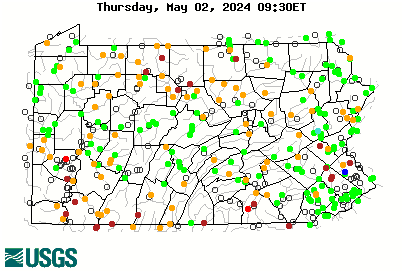After five years of heavy use, my last pair of boots were starting to show their age—especially with all the extra time I’ve spent fishing since retiring. I needed a new pair that could offer better traction on rugged streams like Penns Creek, while also being easier to take on and off multiple times a day. After a week of intensive use, I’m confident I’ve found the best boots I’ve ever worn: the Orvis Pro BOA Wading Boots.
Putting the Orvis Pro BOA Boots to the Test on Pennsylvania Streams
I picked up the boots just before heading to Penns Creek in May. I put them through their paces—using them about ten times over six days, from large rivers to remote brookie streams. Conditions were challenging, with all types of terrain and flow, and the boots performed exceptionally well.
This was my first time using Orvis wading gear, although I’ve followed the brand for years and trust what they bring to the angling community. The Pro BOA Wading Boots have been around for a few years, but this latest version is a refresh introduced within the last year or two.
What Makes the BOA Fit System Ideal for Fly Fishing Boots?
The BOA Fit System, not exclusive to Orvis gear, replaces traditional laces with a precision closure mechanism. It features a dial, steel wire laces, and low-friction guides that deliver a secure, adjustable fit. I first saw BOA on ski boots decades ago, but it has since become popular in everything from cycling shoes to wading gear.
The key benefit is how effortlessly you can tighten or loosen the boots. I didn’t fully appreciate how easy and fast the system was until I tried it in the Orvis store. The wide opening makes it simple to slide your foot in, then a few clicks of the dial ratchet everything down for a snug fit. Releasing the system is even easier—just pull the dial, and the laces loosen instantly, making it easy to slip the boots off.
No more untied laces. No more skipping top eyelets. No more struggling to get wet boots on or off.
Michelin Soles: High-Traction Wading in Slick Streambeds
Orvis partnered with Michelin to create the Outdoor Extreme Tread for these boots. At first, it sounded like a gimmick—but in practice, it’s been a game-changer. I added studs, like any sane angler should in Pennsylvania’s slick streams, and the grip is excellent. Subjectively, they perform better than any boots I’ve used—particularly when wading across the greasy, bowling ball-like rocks in Penns Creek.
Lightweight, Quick-Drying Materials for Multi-Day Trips
The boots feature a microfiber upper that dries quickly and keeps weight down at about 50 oz. I’ve been impressed by how little water the boots retain. After walking out of the stream, they shed water quickly and never felt soggy the next morning. Today was the first time I even considered putting them out in the sun to dry.
There’s a heel pull tab for convenience, but honestly, I haven’t needed it—these boots are that easy to get in and out of.
Fit, Comfort & Sizing Tips
The fit is supportive and comfortable overall. I did notice a bit of pressure over the top of my right foot, likely due to the tongue not being seated properly. It’s isolated to one side, and I expect I can resolve it with some minor adjustment.
Like most wading boots, you’ll want to size up. My feet are normally a 10.5, and when trying them on at the Orvis store, I wore my standard wading socks along with neoprene booties. The boots only come in full sizes, so I went with a size 12—an ideal choice. The BOA system allows for small adjustments, so getting the right snugness isn’t an issue.
Pros and Cons of the Orvis Pro BOA Wading Boots
What I Love:
- BOA Fit System: Lightning-fast to tighten and release
- Michelin Soles: Unmatched traction on wet, rocky surfaces
- Lightweight & Quick-Drying: Ideal for multi-day trips and remote waters
- Orvis Craftsmanship: Durable and built with the angler in mind
- Slight tongue pressure on one foot (adjustable)
- You'll want to carry spare BOA laces for peace of mind, although the system is rugged
Final Verdict: A Top-Tier Wading Boot for Demanding Anglers
The Orvis Pro BOA Wading Boots deliver exceptional performance, comfort, and ease of use. The BOA System simplifies gear changes, while the Michelin treads offer industry-leading traction. These boots have already exceeded my expectations, and I’m excited to keep using them throughout the season.They’re a premium option for anglers who demand high performance and no-nonsense reliability on the water.
(Update after 22 days of hard fishing)
The tongue pressure went away. Must been just stiffness in the material that worked itself out. Love the boots even more. The Michelin soles with studs are awesome, the ease of getting in and out of the BOA boots are fantastic.
Related Resources
You may also like:Paflyfish Gear Talk Forum
Orvis
BOA Fit System
Last edited:




